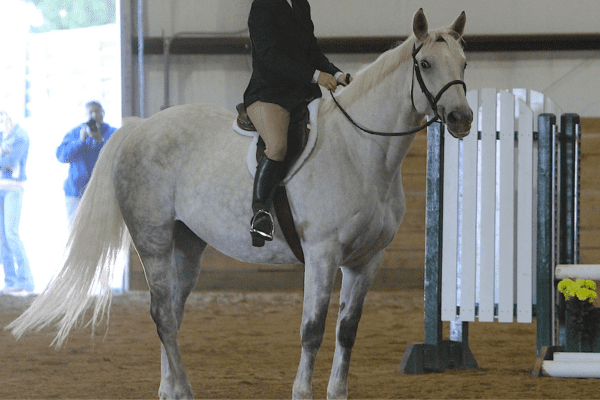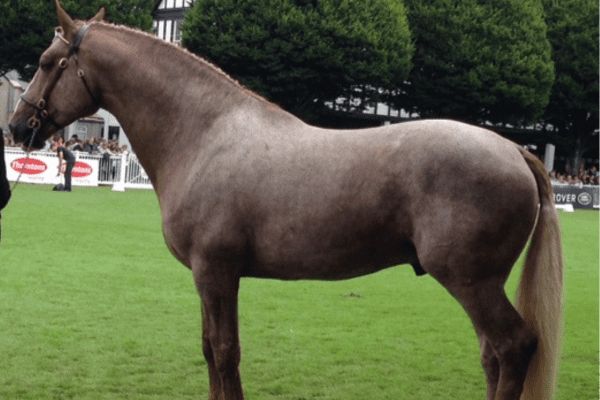The Irish Draught, Ireland’s pride in the equine world, has evolved from its roots as a farm utility horse to a cornerstone in creating elite competition horses. Initially bred to meet the demands of rural farm work, this breed has admirably adapted to the evolving needs of the equestrian sports.
Its most notable contribution is in the genesis of the esteemed Irish Sport Horses, achieved through strategic crossbreeding with Thoroughbreds and warmbloods. These offspring are celebrated for their exceptional performance in top-tier eventing and show jumping arenas, embodying the Irish Draught’s enduring legacy in the equestrian domain.
History:
The Irish Draught horse stands as a testament to centuries of selective breeding and adaptation for agriculture, warfare and sport purposes.
Beginnings and Early Development:
Its origin can be traced back to the 18th century, deriving from Irish Hobby horses renowned for their stamina and agility. This initial genetic foundation set the stage for horses that could meet both rural Ireland’s varied demands while remaining sturdy yet swift.
Crossbreeding Through the Ages:
Over time, Irish Draught horses were crossbred with various horse breeds to obtain specific traits.
In the 12th century, Anglo-Norman war horses emerged, providing both strength and larger bodies.
Influences from Iberian breeds originating in Spain’s 16th-century Armada have given this breed elegance and improved conformity.
Clydesdale blood was often added to horses during the late 19th and early 20th century for increased size, at the expense of endurance and conformation; this drawback was later lessened through Thoroughbred blood transfusions.
Connemara ponies, known for their hardiness, furthered this breed’s versatility and resilience.
The Quintessential Working Horse:
Irish Draught horses were originally developed to serve multiple uses, from draft and farm work, as well as riding. Economical upkeep was paramount; these versatile working horses thrived with minimal feed needs while finding sustenance from natural forages such as gorse, turnips, or any excess cattle feed available in their surroundings.
Government Interference and Breeding Control:
Early 20th-century government involvement was substantial in formalizing and improving this breed.
Registering stallions in 1907 and mares in 1911 with subsidies and inspections was designed to foster high breeding standards.
Establishment of an official Stud Book in 1917 by the Ministry of Agriculture was an essential step toward safeguarding the breed’s lineage, with registration of 375 mares and 44 stallions serving as foundation stock.
Historical Challenges and Survival:
Irish Draught horses have endured numerous hardships throughout their history, from losing original stud book records in a 1922 fire at Four Courts Stud to their participation in World War One where many horses were commandeered for military use and lost forever.
Due to industrialization in the 20th century, horses’ traditional roles became much diminished, leading many to either be exported for slaughter or be sent abroad as exports.
Modern Significance and Legacy:
Irish Draught horses have proven resilient and adaptive over the course of history, earning widespread respect as producing Irish Sport Horses that excel at eventing and show jumping.
This breed’s journey from farm workhorse to respected sport horse is emblematic of Ireland’s cultural and technological change and underscores their enduring place within equestrian sport.

Safeguarding Our Legacy: Exploring and Preserving Irish Draught Horses:
This paper documents both the history and preservation of this breed of draught horse.
The latter half of the 20th century marked a pivotal period in Irish Draught horse history, marked by concerted efforts to protect and promote this historic breed.
Founding Preservation Societies:
In 1976, the formation of the Irish Draught Horse Society heralded a new era for breed preservation; later that same year saw its British branch established.
These societies played an essential role in safeguarding and promoting the breed domestically and internationally.
Governmental and Organizational Involvement:
Bord na gCapall was established that same year, a horse board dedicated to Irish breeds.
In 1993, this body evolved into the Irish Horse Board to reflect a wider mandate promoting various horse breeds including Irish Draught.
Registry Transition and International Expansion:
2008 marked an important administrative change when the Irish Horse Register was transferred from Irish Horse Board to Horse Sport Ireland.
This transfer coincided with the establishment of the Irish Draught Horse Breeders Association – an important step toward unifying breeders under one banner.
Simultaneously, Irish Draught popularity surged internationally and led to the formation of Irish Draught societies across countries like Canada, the US, Australia and New Zealand.
Standardization Initiatives and International Cooperation:
Early 2010s witnessed representative bodies from Ireland, Great Britain and Canada come together to coordinate breed standards and inspection criteria globally – an effort aimed at maintaining breed integrity globally.
Challenges of Popularity and Genetic Conservation:
Irish Draught horses’ growing reputation as foundation stock for sport horses threatened their genetic integrity, leading many mares to produce crossbred sport horses at the expense of purebred Irish Draughts, ultimately decreasing purebred numbers and leading to their decline.
Selective breeding of specific show jumping traits further reduced genetic diversity, while inbreeding within popular performance bloodlines threatened it further.
Recognizing and Responding to Genetic Risks:
Recognizing these risks, global organizations like the Food and Agriculture Committee of the United Nations classified Irish Draught as an endangered maintained breed.
In 2009, the American Livestock Breed Conservancy updated this breed’s status on its Rare Breed Conservation Priority List from “Enlist” to “Watch.”
Initiatives for Genetic Diversity and Breed Standards:
In partnership with the Royal Dublin Society and Irish Cattle Breeding Federation, the Irish Draught Horse Society of Ireland led research to create a breeding strategy focused on genetic diversity as well as traditional traits.
Horse Sport Ireland introduced annual inspections for adult horses registered with its studbook, and other registries quickly followed suit with this practice.
These inspections, designed to create a complete profile for each horse, help determine breeding suitability and preserve breed standards.
A novel four-tier classification system has been implemented to diversify gene pools while still upholding quality.
Horse Sport Ireland also maintains a special section to recognize those Irish Sport Horses which comply with Irish Draught standards.

Characteristics:
The Irish Draught Horse breed, long revered for its strength, versatility, and temperamental traits, adheres to an intricate standard which differs depending on which country one resides in. There has been considerable effort toward harmonization internationally with significant progress made among Ireland, Great Britain, and Canada registries achieving near perfect alignment among their standards.
General Appearance and Temperament:
Irish Draught Horses are well known for their adaptable and athletic build, combining power with refined quality.
This cat boasts an appealing head, belying its friendly disposition. Additionally, its sturdy constitution and inherent soundness have earned its admirers.
This breed is widely recognized for their exceptional temperament, which typically features an appealing combination of docility, willingness, and kind disposition.
Physical Attributes:
A desirable specimen stands between 158 cm (15.2 hands) and 170 cm (16.3 hands).
The breed displays strong, clean, and flat leg bones of about 23 cm (9.1 inches). Their heads are well-proportioned with broad foreheads, ample space between jaws, expressive, kind eyes and an overall pleasing expression.
Irish Draught horses feature long and well-set necks that lead to distinct withers.
Body and Movement:
This breed features an expansive heartgirth indicative of its strong-willed character and well-sprung ribs that allow for freer movement.
Hindquarters on this horse are strong and gently sloped, contributing to its powerful gait.
Movement is one of the primary traits that distinguishes an Irish Draught. Their stride is bold, active and straight with free shoulders and ample flexion.
Hooves are essential parts of horseshoeing and must be hard, sound, and balanced, avoiding extremes in size or shape.
Coat and Coloration:
Acceptable colors for an Irish Draught include solid hues such as bay, brown, grey, chestnut, black and dun. Although white markings are permitted according to breed standard, excessive white may not be desirable in keeping with breed requirements.
The Structured Echelons of Irish Draught Horse Studbooks:
At the forefront of Irish Draught horse breeding lies an intricate classification system. Adopted by various national registries, this classification system doesn’t abide by a binary pass/fail model; rather it involves an intensive inspection process that meticulously evaluates each horse’s conformation, athleticism and movement before placing them into one of four distinct classes that represent how closely their conformance with breed standards can be.
Explore Tiered Classification System:
Class 1: Exemplars of the Breed
Class 1 horses represent the Irish Draught breed standard at its core.
These horses excel both at an official veterinary examination and breed standard assessment.
Breeding Quality Dogs – Puppies made specifically for breeding are ideal as standard-bearers to preserve the finest qualities of each breed.
Class 2: Contenders With Potential
Horses in Class 2, though lacking the ideal breed standard, have passed the veterinary examination successfully.
Their offspring have the opportunity to undergo evaluation, providing a pathway towards potentially reaching Class 1 status.
This tier recognizes and includes horses that contribute to genetic diversity in their breed.
Class 3 – Not Recommended for Breeding
Class 3 horses do not pass an official veterinary examination and therefore belong in this class.
Breeding horses of this class is not advised, as they do not meet essential health and conformation standards.
Their offspring do not qualify for classification upgrades, demonstrating the rigorous quality control within this breed.
Class 4: Uninspected and Prospective :
This classification encompasses horses that have not undergone the formal inspection process yet.
Their classification remains open, with potential placement into any of the above classes upon assessment.
Offspring from Class 4 horses remain unclassified until their parents’ evaluation has taken place.
This multi-tiered classification system serves as the cornerstone of Irish Draught horse breed preservation and enhancement. This classification system dissects horses according to quality, conformance to breed standards and evolution rather than simple binary judgment – this ensures both integrity of breed, as well as continued excellence – throughout global equestrian circles – keeping revered status of Irish Draughts within global equestrian community equine community equestrian community through systematic evaluation that upholds its legacy of quality, grace, and distinguished heritage through systematic and thorough evaluation from Irish Draught studbook!
Temperament:
Irish Draught horses are known for their outstanding temperament. Calm, intelligent, and willing companions for riders of all levels and experience levels alike. Their gentle demeanor does not compromise their spirited energy either making them perfect companions for leisure riding as well as competitive sports riding.

Versatility in Equestrian Sports:
Irish Draught horses have made an indelible mark on equestrian sports. From show jumping and eventing to dressage and even fox hunting and field sports, their power and agility make them popular choices for Irish Draughts bred from thoroughbred crosses are well known worldwide as Irish Sport Horses.
Cultural and Historical Significance:
Irish Draught horses have long been revered symbols of Irish culture and history, representing our heritage and national identity. At one point during the mid-20th century, however, due to mechanization and changes in farming practices they almost went extinct; but efforts made by breed enthusiasts and government helped revive and preserve this iconic breed.

